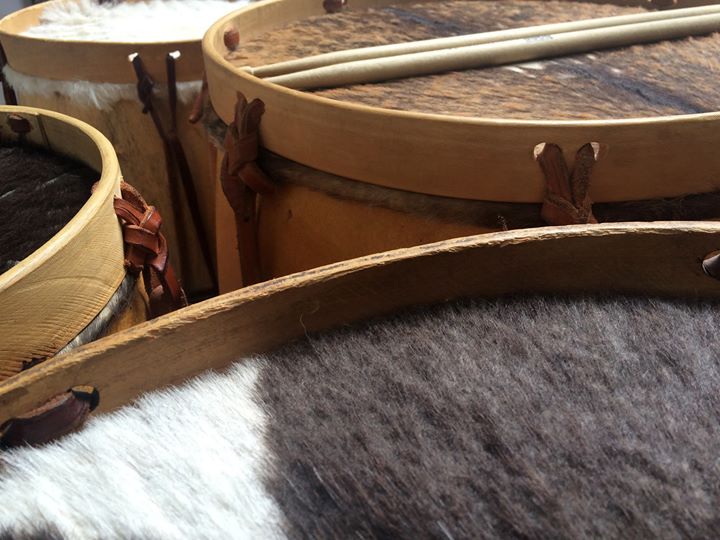Carlos Franco, in addition to being an exceptional drummer, is also an outstanding percussionist both classical and folkloric. He has a strong command of a wide variety of Afro-Venezuelan rhythms and has been able to integrate them seamlessly into the music of Kotebel.
This article presents an exploration through the music of Kotebel, from “Omphalos” to the “Concerto for Piano and Electric Ensemble”, in order to find these hidden gems….
Luango
This rhythm, together with others like “Sangueo”, are typical from the Venezuelan state of Yaracuy, and particularly in the town of Veroes. They are closely related to the festivities of St. John the Baptist, which take place – as in many other regions in the World – on the summer solstice in June 24th.
The “Luango” has several patterns; among the most important ones is the “Luango Corrío”:
The “Luango Corrío” is used in the introduction, middle and closing sections of “Ra” from the “Omphalos” album:
Ra – Introduction
Ra – Middle Section
Sangueo
There are many variants of this rhythm, played in several regions throughout Venezuela. One of this variants was also originated in Veroes, in the state of Yaracuy:
This rhythm is also used in “Ra” from the “Omphalos” album, but this time the pattern is executed directly in the drums:
The “Sangueo” is also used in the “Sun Pentacle” from the “Pentacle Suite” – “Omphalos” album:
And in “Adagio Maestoso” from the “Concerto for Piano and Electric Ensemble”:
A minute later, also within the “Adagio Maestoso”, another variant of Sangueo called “Sangueo de Cata”, from the state of Maracay, is used:
Adagio Maestoso – Sangueo de Cata
In all these cases the “Sangueo” is presented using a regular drum set instead of the original instruments.
San Millán
As is the case with the Sangueo and Luango, “San Millán” is also related to the festivities of St. John the Baptist. But this time we move to the center of Venezuela, to a state called Carabobo:
This rhythm is used in “Ouroboros” from the album “Ouroboros”:
And in “Vivo Scherzando” from the “Concerto for Piano and Electric Ensemble”:
It can be heard more clearly in the live version. This is taken from the live album “Live at Prog-Résiste”:
Bikutsi
This popular rhythm comes from Camerun. The word ‘bikutsi’ literally means ‘beat the earth’ or ‘let’s beat the earth’ (bi- indicates a plural, -kut- means ‘to beat’ and -si means ‘earth’.) The name indicates a dance that is accompanied by stomping the feet on the ground:
This rhythm is used in the live version of Mysticae Visiones, included as a bonus track in the album “Ouroboros”.
In this case the stomping is emulated with the kick drum:
Calipso
This rhythm is typical from the region of Guyana, in the south of Venezuela. It is also very popular in Trinidad Tobago and along the Caribbean cost in Central America and the Antilles. In Venezuela, this rhythm is widely used during the carnival festivities, and in particular in the city of “El Callao”, were workers from Trinidad & Tobago moved in order to work in the mines. This is the only mainland region where this rhythm is played:
This pattern is used several times in “Simurgh” from the “Ouroboros” album:
Gaita de Tambora
This Afro-Venezuelan rhythm originated in the towns located at the south of the Maracaibo Lake in the states of Zulia and Mérida, Venezuela (Bobures, Palmarito, Gibraltar , etc.). It is played in honor of St. Benito, usually between the months of December and January.
This rhythm is used as part of a complex polyrhythmic section in “Sun Pentacle”.
Appears in the beginning, middle and ending of this fragment:
It is also used in “Adagio Maestoso” from the “Concerto for Piano and Electric Ensemble”:
Chimbanguele (Golpe de Misericordia)
The Chimbanguele is also part of the musical tradition of the towns located at the south of the Maracaibo Lake, and also in honor of St. Benito. There are different patterns or “golpes”: Cantica, Chocho, Ajé, Chimbangalero Vaya, San Gorongome Vaya and Misericordia.
This is an example of “Golpe de Misericordia”:
This rhythm is used in the introduction of “The Flight of the Hippogriff Part II” included in the album “Concerto for Piano and Electric Ensemble”:
Credits
Luango Corrío
Tambores de Veroes Estado Yaracuy 24/06/12, Palmarejo, San Juan.
Published by: Reydogcafe
Link to full video: https://youtu.be/yHLjCrKjsSQ
Sangueo
Introducción a la Percusión y la cultura de las comunidades Afrovenezolanas.
Remigio “Memo” Piñate, Jhony Bueno.
Madera Presenta
Published by: MaderaPresenta
Link to full video: https://youtu.be/9fXrhMwb0pQ
Sangueo de Cata
Asociación Civil “Comacu” – Para la Conservación de las Manifestaciones Culturales Venezolanas.
Song: Pajarillo de Siete Colores
Published by: Comacu DeVenezuela
Link to full video: https://youtu.be/3sS42IuAyUk
San Millán
Introducción a la Percusión y la cultura de las comunidades Afrovenezolanas.
Remigio “Memo” Piñate, Jhony Bueno.
Madera Presenta
Published by: MaderaPresenta
Link to full video: https://youtu.be/BM0Zbv3bq-g
Bikutsi
Atna Njock & BOLBO ART – Rythme traditionnel Bikutsi du Cameroun
Published by: BolboArt
Link to full video: https://youtu.be/1NLu1k3OgDM
Calipso
Como tocar Calipso. Ciudad Bolivar, Venezuela
Published by: Nestor Villar
Link to full video: https://youtu.be/JO6ZoNKW99k
Gaita de Tambora
GAITA DE TAMBORA EL 06 DE ENERO DEL 2012 EN PALMARITO EDO MERIDA
Gaita de Tambora el 6 de enero de 2012, en Palmarito Estado Mérida
Published by: tati carama basabé
Link to full video: https://youtu.be/vT22v7A-L50
Chimbanguele (Golpe de Misericordia)
Presentación de los Tambores Chimbángueles de Bobures (Edo. Zulia – Venezuela) en la Casa de la Diversidad Cultural
Ritmo: Golpe Misericordia
Año 2008
Asociación Civil “Comacu” – Para la Conservación de las Manifestaciones Culturales Venezolanas.
Published by: Comacu DeVenezuela
Link to full video: https://youtu.be/aKigGLtP5hA



Great! Sometimes we take for granted how important different rhythms influence the music we hear as listeners or as musicians. Sometimes it catches our attention so fast and strong we forget to recognize it in a more appreciative way.